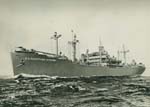During the first half of the 1940s, Augustana felt the effects of World War II as it lost some students to the armed services and gained others through a cadet training program organized by the Department of War. Thanks to the G. I. Bill, enrollment increased significantly after the war's end, as it did at colleges and universities throughout the United States. The biggest change Augustana experienced in this decade, however, was to the structure of the school itself: in 1947, the Augustana Synod voted to separate the college and theological seminary. President Bergendoff lamented the synod's decision as going counter to Augustana's premises and strengths; the united college and seminary, he wrote in his president's report of 1947-1948, had been "testimony to an academic world, all too split into unrelated parts, that our Church believed that all truth is of God and all learning is related to the Word."
- March 30, 1943
- First group of Army Air Force cadets arrives on campus. The cadets are students with prior military experience who are to study at Augustana as they work to obtain the rank of second lieutenant in the Army Air Corps. Over 1000 cadets will study at Augustana before the Department of War calls an end to the training program in June 1944.
- May 16, 1945
- S. S. Augustana Victory, a 10,800 ton cargo vessel named for Augustana College, is launched in the San Francisco Bay at Richmond, California. Speaking at the dedication, Lt. Victory E. Pearson ('40) expresses thanks for the honor to her alma mater and gives the United States Maritime Commission $200, on behalf of the Association of Alumni and Former Students of Augustana, for the purchase of a library for the vessel's crew; the library is dedicated to the Augustana students who served in WWII.
- April 26, 1946
- College Conference of Illinois forms. Augustana is a founding member of the new athletic conference, along with Carthage, Elmhurst, Illinois College, Illinois Wesleyan, Lake Forest, Millikin, North Central, and Wheaton. In 1967, in response to expanding and changing membership, the conference will change its name to the College Conference of Illinois and Wisconsin (CCIW), of which Augustana remains a member to the present day.
- September 1947
- Enrollment reaches record high of over 1700 students; this includes 1,283 students in the College of Liberal Arts, 210 music students, 212 evening school students and 86 seminary students. The spike in enrollment is similar to those at schools across the country post-WWII, as veterans study under the G.I. Bill. Enrollment will decrease again in future years.
- August 31, 1948
- College and theological seminary separate. On June 13, 1947 the Augustana Synod voted that the college and the seminary should function as two distinct institutions, with separate boards, administration, funds, and property; this change takes effect in the 1948-1949 school year. The seminary will retain its Rock Island location for nearly 20 more years. In 1962, it will merge with three other seminaries to form the Lutheran School of Theology at Chicago; with the dedication of the LSTC's Hyde Park campus in 1967, the seminary will permanently leave Rock Island.
- February 24, 1949
- First panty raid. A number of male students enter the Woman's Building (now Evald Hall) late at night and spend ten minutes overturning furniture, dumping "co-eds" into showers and soaking mattresses; some take lingerie as a souvenir. At least, so say news stories across the country and the world on February 25; President Bergendoff will release a statement a few days later saying that the raid did little actual damage and was fully anticipated by the female students. This first panty raid starts a trend at colleges and unversities across the country that will continue until the 1960s.


